
The past few decades has seen increasing kinematic studies using surface electoromyography (EMG) in archery, however there has been no such specific study in Korean traditional archery. The purpose of this study was to evaluate EMGs during archery shooting motion in Korean traditional archers. Ten men Korean traditional archers were participated, and divided into two groups according to the shooting stance; parallel stance group(PSG, n=5) and oblique stance group(OSG, n=5). The surface EMGs were measured 12 muscles during shooting motion of five events including Junbi(Set), Geogung(Set up), Manjak(Full draw), Balsi(Release), Machigi(Ending). At the result, muscle activity of posterior deltoid, trapezius, rhomboid major, latissimus dorsi, biceps brachii, forearm extensor bundle, triceps brachii, levator scapulae significantly increased at event of full draw and release, then significantly decreased again at event of ending, respectively(p<.01, p<.001). The muscle activity of erector spinae(ES) was also significantly increased at event of full draw and release(p<.01, p<.001), while no significant changes in muscles of rectus abdominis, rectus femoris(RF), gluteus maximus. As a result of comparing PSG and OSG, muscle activity of RF in OSG was higher than PSG at event of release(p<.05), it remained until event of ending(p<.05). On the other hand, the higher the tension of the bow, the higher the muscle activity of the draw arm at event of release(p<.05). These results suggest that when Korean traditional archery shooting, both side arm and back muscles are more activated than the abdomen, leg and hip muscles. The parallel stance might suppress the muscle activity of the lower extremities to twist the upper body. And the higher bowstring tension needs to increase of muscle strength in BB of draw arm.


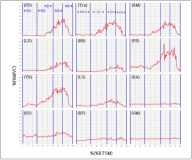
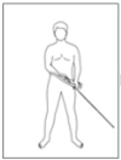
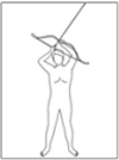
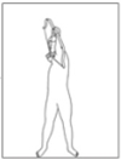

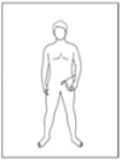
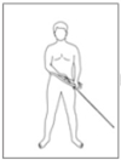
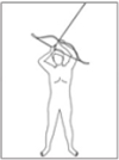
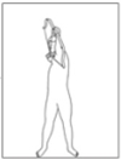
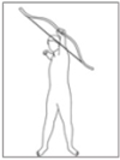
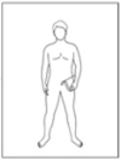

Purpose The purpose of this study is to analyze issues of sexual violence case in sports field reported in the press by using spline function model and text mining. In specific, spline function model is used to measure social interest level based on issue attention cycle theory and figure out the flow of issues by applying text mining. Methods Study material is 2,660 news articles reported from January 1, 2017 to December 31, 2019 and press DB(Big Kinds) of Korea Press Foundation is used to collect study material. Results Social interest level on sexual violence case in sports field is dramatically increased due to disclosure of Sim player starting from Me Too movement started from the culture and art world. Because of this, as structural problem in sports field arises, social interest level comes to a climax, and then it was founded that the government’s countermeasures establishment and special audits by the Ministry of Education were in progress. From the perspective of the issue attention cycle, it has the stages of latent-occurrence-rising-decision-decay-disappearance, but the period from rising to declining is short, so it corresponds to a breaking issue attention cycle. Conclusion This study examines the progress of sexual violence case in sports field from rising to disappearance in the perspective of the issue attention cycle. With this incident, the world of sports is establishing sports ethics center and proceeding policies such as Basic Sports Act, and the future studies need to review the effectiveness of this policy.

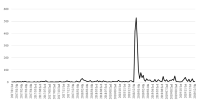
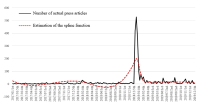
Purpose The purpose of this study was to develop the Emotional Intelligence Scale in Sport Coaching(EISSC) based on the emotional intelligence trait model. Methods The participants were 236 professional sports coaches by the purposive sampling methods via e-mails. 48 preliminary items were developed by literature review among expert panels. Then, a total of 40 items were selected after the item-analysis. Exploratory factor analysis was conducted for construct validity and criterion validity was evaluated by Person’s correlation with coaching efficacy scale and general emotional intelligence scale. An internal consistency, Cronbach's alpha coefficient, was used to see the reliability. Results The results of exploratory factor analysis presented a six sub-structure factors (Self-awareness, Awareness of others, Optimism, Utilization of emotion, Emotion regulation, Social skills) with 20 items, which explained 68.49% of the total variance. Criterion-related validity was supported by correlations with in coaching efficacy(r=.713) and general emotional intelligence(r=.647). Reliabilities were secured with Cronbach’s alpha coefficient .854 for the total 20 items. Conclusions The EISSC can be used to provide an valid measure of emotional ability of coaches in sport.

Purpose This is to provide essential data for training necessary for sweeping through the analysis of muscle activity generated at this time and how much sweeping and what trajectory moves the stone when the movement of the stone is controlled through sweeping. Methods To check and record the distance between the stones by checking the stop position of the stone made by sweeping each section, the length (progress distance) and width (progress direction) were recorded using a reference table and a record preparation table. With the EMG attached, a total of 60 sweeps were made 20 times each from the beginning of the section to the end of the section. Sweeping subjects were asked to sweep as much as possible under the same conditions in all three sections. Results As a result of the study, the muscle mobilization patterns of the 1st and 2nd sections of the stone with the faster speed and the 3rd section with the stone's slower speed appeared differently. It was confirmed that the sweeping motion of curling is a motion that is used evenly among the muscles of the upper extremity, and it can be verified that it is a suitable item for the development of upper body muscles. Also, the right deltoid's muscle activity rate during push and the right triceps brachii during pull was high. Conclusion Each section of the stone's sweeping effect is an exercise that has many variables, such as changes in atmospheric temperature and humidity, changes in ice temperature, temperature-size-number of pebbles, and the edge state-resilience of stones, etc. It is judged that experience can cope with these variables and requires training.

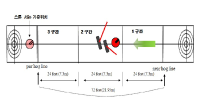
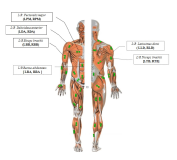
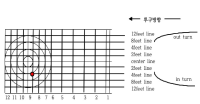
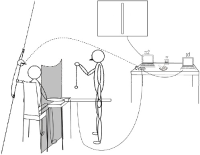
Purpose This study measured the haptic extroperception accuracy, that is, judging one hit position in a hand-held object. Especially, what factors associated the estimation of contact position when the impact is made at the grasped implement by hitting the ball. Methods Relative frequency and conditional probability based analysis verified that perceivers influenced not only the amount of pressure distinguished impressions by the coefficient of restitution but also the pressure distributions encoded impressions by the distance from the hand to the impact. Results Results conformed to previous invariant characteristic on dynamic touch in showing that perceiving the location of the impact of grasped objects, including dominant perceiving selectively modality, is constrained by inertial properties with such success requires appreciating the location of the implement’s center of percussion. Conclusion Investigated in this planes captured as a mechanical factor, we would suggest a broader hypothesis for further research into the effects of the rotational inertia related to haptic position accuracy in the hand-held object, and leading to different estimates of system function providing an account of generalization that accommodates of its varied aspects.





Purpose The purpose of this studied to improve athletes’ performance through sports psychological skills training and counseling of a male canoe player in high school. Methods One male high school athlete in J area was interviewed for sports psychological skills training and counseling, and interviewed athletes and coaches diagnosed the potential psychological problems of athletes. Through this process, the athlete gained the ability to control anxiety about the game and strengthened the attention-focused ability to increase his confidence and set a goal for improving concentration. For effective training, sports psychological counselors, athletes, and coaches met once a week to create a routine. and participated in direct training on a boat with the coach every week. Sports psychological skills, anxiety about competition, and self-management of athletes were measured before and after to confirm the effectiveness of training of athletes' psychological skills. Results As a result, athletes' psychological skills and anxiety decreased, their confidence increased, and their concentration, which was diagnosed as an urgent problem of athletes, improved. Conclusions psychological skills of athletes, psychological shortcomings of players were reinforced, thus enhancing the athletes' performance. This suggests the effectiveness and necessity of training in sports psychological skills. It is hoped that continued support will serve as an opportunity to diagnose potential psychological problems of student athletes and apply them to training to contribute to improving their performance.
Purpose The purpose of this study is to examine the differences in physique and physical fitness factors affecting exercise performance according to the vitamin D receptor (VDR) FokI gene polymorphism in athletic gifted children. Methods FokI VDR polymorphisms were genotyped in 82 boys (9.1±0.9 years) and 55 girls (9.3±0.9 years). Basic physical fitness (basketball throw, half-squat jump, standing long jump, 15m pacer, 50m run, handgrip strength, side-step, trunk forward flexion, sit-up) and physique were measured and analyzed using one-way ANOVA with bonferroni’s correction. Results No association was found between the VDR FokI genotypes and all the physical fitness variables as well as physique variables in boys and girl. However, Hardy-Weinberg equilibrium results for VDR polymorphism distribution showed significant differences (χ2= 6.516, df=2, p=.038). Conclusion Although there was no significant difference in the fitness variables according to the VDR Fok1 genotype, it was difficult to exclude the potential for predicting fitness in that the H-W equilibrium test showed a significant difference. Therefore, in order to confirm the true potential of the VDR Fok1 gene to predict physical fitness, it is considered that additional studies on general children should be conducted.
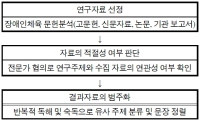
Purpose This study examines the Physical Education curriculum history of special schools, and then in-depth grasps the process of how the sports environment for the disabled has changed by age. Method The research method was literature review analyzing papers, reports and newspapers. For the concrete process, this study verified the relationship between the research subject and the collected data through experts and historians with disabilities to verify the sports data for the disabled. Results First, the process of physical education management of special schools is as follows. in the 1940's and 50's special schools, physical education was carried out simply by gymnastics. but, special schools were differentiated by the characteristics of the disabled, and the institutional foundation for physical education was also imitated by the 1960s, 1970s and 1980s, special schools were shortened in physical education time due to the increase in the number of courses and the strengthening of disability coping programs. in the 1990s, as special sports curriculum was established, customized prescription for students with disabilities was implemented. Second, the process of changing disability sports is as follows. In the 1960s and 1970s, disability sports were mainly focused on special schools, while in the 1980s, disability sports were expanded by the government. in particular, the hosting of the 88 Seoul Olympics and Seoul Paralympics provides an opportunity to equip the disabled with a system, organization and facilities. in the 1990s disability sports was meaningful in terms of academic progress, and with the quantitative growth of the 1980s and the academic foundations of the 1990s, disability sports in the 2000s provided a legal basis and improved welfare conditions for the disabled. In the future, it is necessary to find a way to solve the value of physical education for the disabled more reasonably.

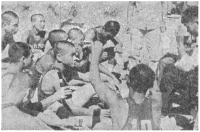
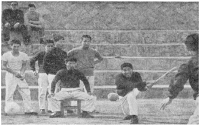
Purpose The purpose of this research is to provide implications for the study of the physical education curriculum in Korea and China by comparatively analyzing the revised high school physical education curriculum in the two countries. Methods Using Bereday(1964)’s four steps of comparison model in education, this study focuses on the format and content of the general high school physical education curricula of Korea and China, each curriculum having been revised respectively in 2015 and 2017. Results First, in terms of format, both countries consider PE a necessity and share similarities in regard to course structure, credit allocation and document format. Nevertheless, though both countries are oriented toward competency-centered education, there are some differences with respect to official education curriculum documents, numbers of subjects and hours of study based on the reality and situation of each country. Second, in terms of content, both countries present various teaching methods and evaluation principles for the sake of acquiring core competence. However, the Korean curriculum prefers to advocate learning of the value of physical activity to achieve core competencies, while the Chinese curriculum prefers to focus on acquiring athletic skills and health knowledge for achieving core competencies. Conclusions After comparing physical education curriculum in both countries, two implications could be obtained. One is that the consistency problem in Korea should be solved between the core competency, the teaching and learning methods and evaluation standards. The other is that, in China, integrated value of physical education should be paid more attention and core competency as well as teaching and learning methods should be considered.
Purpose The purpose of this study was to investigate the effects of training methods on body composition, isokinetic strength and muscle endurance, cardiopulmonary function, and anaerobic power in female judo players. Methods Subjects performed weight training (n=10) and circuit weight training (n=10) consisting of 10 sports items for 12 weeks. In order to analyze the effects of training, body composition, isokinetic strength and muscle endurance, cardiopulmonary function, and anaerobic power were measured and the effect of training was verified. Results First, the comparison of body composition between WT and CWT groups showed that significant interaction effect between group and period was found in all variables (weight: F=1082.694, p=.001, body fat mass F=199.999, p=.001; skeletal muscle mass F=2481.698, p=.001, and percentage body fat: F=496.246, p=.001). Second, there was a significant interaction effect between group and duration in shoulder muscle strength and knee endurance (EPTL: F=6.598, p=.019; EAPL: F=12.860, p=.002). Conclusions The result of this study showed that the interaction effect between period and group was not significant according to the training method but the overall effect of the circuit weight training group was more positive than the weight training group. Therefore, it can be concluded that the 12 weeks circuit weight training can contribute to improve the performance of female Judo players by improving body composition, strength and muscle endurance, cardiopulmonary function and anaerobic power.